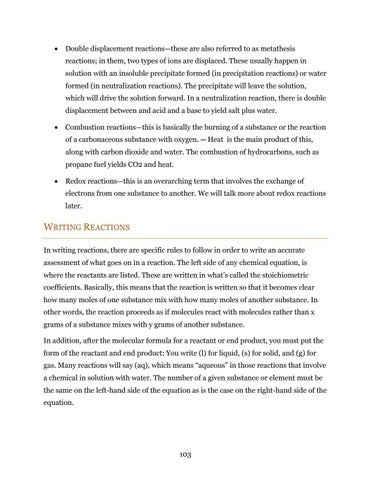•
Double displacement reactions—these are also referred to as metathesis reactions; in them, two types of ions are displaced. These usually happen in solution with an insoluble precipitate formed (in precipitation reactions) or water formed (in neutralization reactions). The precipitate will leave the solution, which will drive the solution forward. In a neutralization reaction, there is double displacement between and acid and a base to yield salt plus water.
•
Combustion reactions—this is basically the burning of a substance or the reaction of a carbonaceous substance with oxygen.
Heat is the main product of this,
along with carbon dioxide and water. The combustion of hydrocarbons, such as propane fuel yields CO2 and heat. •
Redox reactions—this is an overarching term that involves the exchange of electrons from one substance to another. We will talk more about redox reactions later.
WRITING REACTIONS In writing reactions, there are specific rules to follow in order to write an accurate assessment of what goes on in a reaction. The left side of any chemical equation, is where the reactants are listed. These are written in what’s called the stoichiometric coefficients. Basically, this means that the reaction is written so that it becomes clear how many moles of one substance mix with how many moles of another substance. In other words, the reaction proceeds as if molecules react with molecules rather than x grams of a substance mixes with y grams of another substance. In addition, after the molecular formula for a reactant or end product, you must put the form of the reactant and end product: You write (l) for liquid, (s) for solid, and (g) for gas. Many reactions will say (aq), which means “aqueous” in those reactions that involve a chemical in solution with water. The number of a given substance or element must be the same on the left-hand side of the equation as is the case on the right-hand side of the equation.
103
